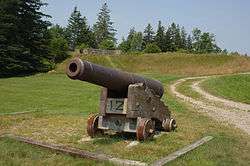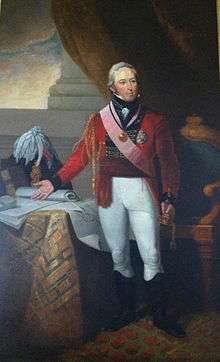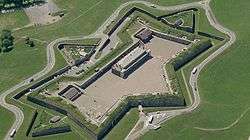New Ireland (Maine)

New Ireland was a Crown colony of the United Kingdom established in modern-day Maine after British forces captured the area during the American Revolution and again during the War of 1812. The colony lasted four years during the Revolution, and eight months during the War of 1812. At the end of each war the United Kingdom ceded the land back to the United States under the Treaty of Paris and Treaty of Ghent, respectively.
American Revolution

In 1779 the British adopted a strategy to seize parts of Maine, especially around Penobscot Bay, and make it a new colony to be called "New Ireland". The scheme was promoted by exiled Loyalists Dr. John Calef (1725–1812) and John Nutting (fl. 1775-85) and Anglo-Irishman William Knox (1732–1810). It was intended to be a permanent colony for Loyalists and a base for military action during the war.[1]

In early July 1779, nearly three years after the American Patriots had declared independence from Britain, a British naval and military force under the command of General Francis McLean sailed into Castine's commodious harbor, landed troops, and took control of the village. They began erecting Fort George on one of the highest points of the peninsula.
Alarmed by this incursion, the Commonwealth of Massachusetts sent the Penobscot Expedition led by Massachusetts general Solomon Lovell and Continental Navy captain Dudley Saltonstall (seconded by Gen. Peleg Wadsworth and Col. Paul Revere was given charge of the ordnance). The military expedition consisted of a fleet of 19 armed vessels and 24 transports, carrying 344 guns.
Although badly outnumbered, McLean and his British forces (the 74th Regiment and the 82nd Regiment) withstood the 21-day siege and the Americans were routed by the arrival of British reinforcements under the command of Collier. The Royal Navy blocked an escape by sea so the Patriots burned their ships near present-day Bangor and walked home.[2] New England was unable to repel the British threat despite a reorganized defense and the imposition of martial law in selected areas of Maine. Some of the most easterly towns tried to become neutral.[3]
The battle was one of the greatest British victories of the war. The failed Penobscot Expedition, which cost the revolutionaries eight million dollars and 43 ships, proved to be the greatest American naval defeat until Pearl Harbor in 1941. The 74th Regiment held Majabagaduce until the end of the war, when it was ceded to the Americans as part of the peace settlement. Saltonstall and Revere were later court-martialed, charged with cowardice and insubordination; the boards found Saltonsall guilty, but acquitted Revere.

At the end of the Revolutionary War, many American Loyalists in the area migrated eastward to the Canadian Maritimes, some towing their houses behind their boats. Subsequently known as United Empire Loyalists, they crossed the newly established international boundary line of the St. Croix River and established St. Andrews, one of the oldest towns in New Brunswick. In addition, many soldiers of the 74th chose to be disbanded in St. Andrews (last muster May 24, 1784), and took up land grants there along with the Loyalists, rather than return to Britain.[5]
After the peace was signed in 1783, the New Ireland proposal was abandoned. In 1784 the British split New Brunswick off from Nova Scotia and made it into the desired Loyalist colony, with deference to King and Church, and with republicanism suppressed. It was almost named "New Ireland".[6]
The Treaty of Paris that ended the war was ambiguous about the boundary between Maine and the neighboring British provinces of New Brunswick (Sunbury County, Nova Scotia) and Quebec. This would set the stage for further fighting in the nineteenth century.
The New Ireland colony and the Penobscot expedition was fictionalised in the 2010 novel The Fort by British author Bernard Cornwell.
War of 1812

During the War of 1812, from his base in Halifax, Nova Scotia, in August and September 1814, Lt Governor of Nova Scotia John Coape Sherbrooke sent a naval force and 500 British troops under the command of Vice Admiral Colpoys to conquer Maine and re-establish the colony New Ireland. In 26 days, they succeeded in taking possession of Hampden, Bangor, and Machias, destroying or capturing 17 American ships. They won the Battle of Hampden (losing two killed while the Americans lost one killed) and occupied the village of Castine for the rest of the war.
The Treaty of Ghent returned this territory to the United States. The British left in April 1815, at which time they took £10,750 obtained from tariff duties at Castine. (The British did not give up Fort Sherbrooke at Eastport, Maine until 1818.) The brief life of the colony yielded customs revenues, called the "Castine Fund", which were subsequently used to finance a military library in Halifax and found Dalhousie College.[7] Dalhousie University has a street named "Castine Way".[8] (Ironically, the British military burned Belfast, Maine in 1779, then held it for five days in September 1814 during the War of 1812.[5]
See also
Notes
- ↑ Robert W. Sloan, "New Ireland: Men in Pursuit of a Forlorn Hope, 1779-1784," Maine Historical Society Quarterly, 1979, Vol. 19 Issue 2, pp 73-90
- ↑ Woodard, Colin. The Lobster Coast. New York. Viking/Penguin, ISBN 0-670-03324-3, 2004, pp. 139-140
- ↑ James S. Leamon, "The Search for Security: Maine after Penobscot," Maine Historical Society Quarterly, 1982, Vol. 21 Issue 3, pp 119-153
- ↑ Sir John Moore at Castine. Maine Historical Society. Series 2, Vol. 2, p. 403
- 1 2 Coolidge, Austin J.; Mansfield, John B. (1859). A History and Description of New England. Boston, Massachusetts. pp. 50, 87–90.
- ↑ Ann Gorman Condon, The Envy of the American States: The Loyalist Dream for New Brunswick (1984)
- ↑ "Sir John Coape Sherbrooke". Dictionary of Canadian Biography Online. University of Toronto. Retrieved 22 December 2012.
- ↑ D.C. Harvey, "The Halifax–Castine expedition," Dalhousie Review, 18 (1938–39): 207–13.
References
- Samuel Francis Batchelder. The Life and Surprising Adventures of John Nutting, Cambridge Loyalist: And His Strange Connection with the Penobscot Expedition of 1779 (1912)
- Joseph Williamson. The Proposed Province of New Ireland. Collections of the Maine Historical Society 1904
- R. W. Sloan, “New Ireland: loyalists in eastern Maine during the American revolution” (phd thesis, Mich. State Univ., East Lansing, 1971).
